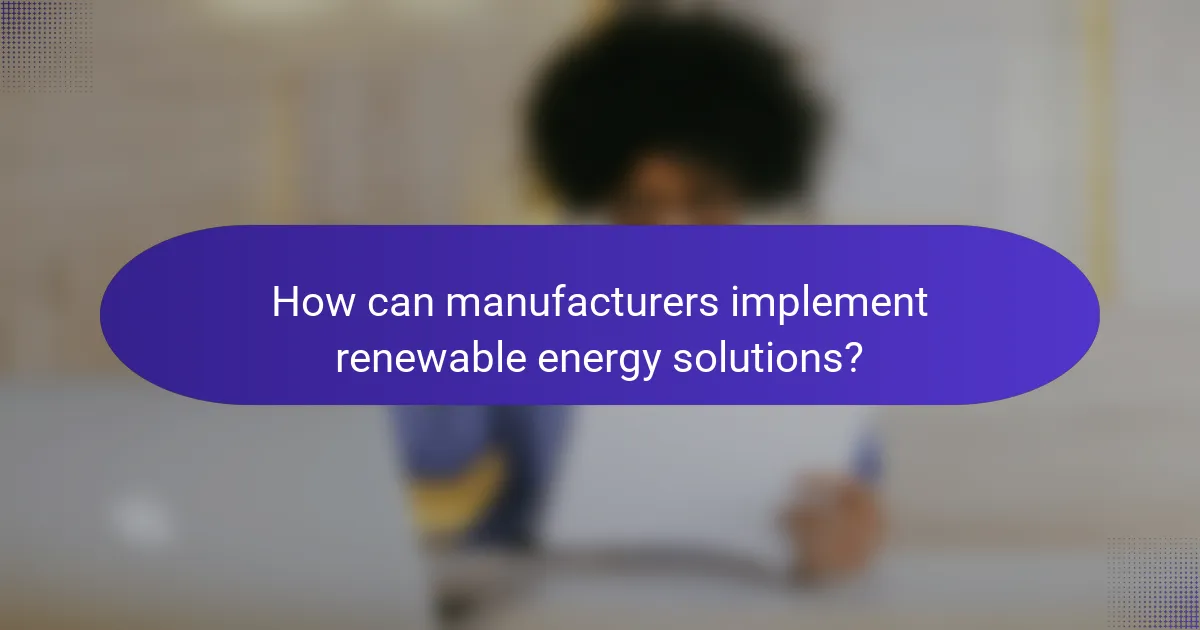Renewable energy plays a crucial role in the manufacturing sector by driving down costs, reducing environmental impact, and improving corporate reputation. By integrating sources such as solar, wind, and biomass, manufacturers can enhance energy efficiency and achieve significant long-term savings while meeting sustainability goals and regulatory requirements.

How does renewable energy impact manufacturing in the United States?
Renewable energy significantly impacts manufacturing in the United States by reducing costs, minimizing environmental harm, and enhancing corporate image. Manufacturers adopting renewable sources like solar and wind can achieve operational efficiency while aligning with sustainability goals.
Reduces operational costs
Utilizing renewable energy can lead to substantial savings on operational costs for manufacturers. By investing in solar panels or wind turbines, companies can decrease their reliance on traditional energy sources, which often fluctuate in price. Over time, these investments can result in lower energy bills and predictable energy expenses.
For instance, manufacturers can expect to save anywhere from 10% to 30% on energy costs by switching to renewable sources. Additionally, many states offer incentives and tax credits that can further reduce initial investment costs, making the transition more financially viable.
Minimizes carbon footprint
Shifting to renewable energy sources helps manufacturers significantly reduce their carbon footprint. Unlike fossil fuels, renewables produce little to no greenhouse gas emissions during operation, contributing to a cleaner environment. This transition is crucial as industries face increasing pressure to meet sustainability standards and regulations.
Manufacturers can track their emissions reductions through tools and certifications, such as ISO 14001, which can help them benchmark their sustainability efforts. By adopting renewable energy, companies not only comply with environmental regulations but also contribute to global efforts to combat climate change.
Enhances brand reputation
Embracing renewable energy can greatly enhance a manufacturer’s brand reputation. Consumers are increasingly favoring companies that demonstrate environmental responsibility, and using clean energy sources can be a strong selling point. This commitment can differentiate a brand in a competitive market.
Moreover, manufacturers can leverage their use of renewable energy in marketing campaigns, showcasing their dedication to sustainability. This not only attracts eco-conscious customers but can also foster loyalty among existing clients who value corporate responsibility.

What are the benefits of renewable energy in manufacturing?
Renewable energy in manufacturing offers numerous advantages, including enhanced energy efficiency, significant cost savings over time, and improved compliance with regulations. These benefits not only contribute to a sustainable future but also enhance the competitiveness of manufacturing operations.
Increased energy efficiency
Utilizing renewable energy sources, such as solar or wind, can lead to increased energy efficiency in manufacturing processes. By integrating these technologies, companies can optimize their energy consumption, reducing waste and lowering operational costs.
For example, manufacturers that install solar panels may generate their own electricity, minimizing reliance on grid power and decreasing energy losses associated with transmission. This shift can result in a more resilient energy system within the facility.
Long-term cost savings
Investing in renewable energy can yield substantial long-term cost savings for manufacturers. While the initial capital outlay for renewable technologies may be significant, the reduction in energy bills can lead to a return on investment within a few years.
Many manufacturers report savings of 20-50% on energy costs after transitioning to renewable sources. Additionally, government incentives and tax credits can further enhance these savings, making renewable energy a financially attractive option.
Regulatory compliance advantages
Manufacturers adopting renewable energy often find it easier to comply with environmental regulations. Many regions have set ambitious targets for reducing carbon emissions, and using renewable sources can help companies meet these requirements.
By proactively integrating renewable energy, manufacturers can avoid potential fines and penalties associated with non-compliance. Furthermore, demonstrating a commitment to sustainability can enhance a company’s reputation and appeal to environmentally conscious consumers.

What renewable energy sources are commonly used in manufacturing?
Manufacturing commonly utilizes solar, wind, and biomass energy sources to reduce reliance on fossil fuels and lower operational costs. These renewable energy options not only enhance sustainability but also improve energy security and compliance with environmental regulations.
Solar energy systems
Solar energy systems harness sunlight through photovoltaic panels or solar thermal collectors to generate electricity or heat. In manufacturing, these systems can significantly reduce energy costs, especially in regions with high solar insolation.
When implementing solar energy, manufacturers should consider factors such as roof space, local climate, and available incentives. For instance, in the U.S., the federal solar tax credit can cover a substantial portion of installation costs, making it an attractive option.
Wind energy solutions
Wind energy solutions involve the use of wind turbines to convert wind into electricity. For manufacturers located in areas with consistent wind patterns, this can provide a reliable energy source that lowers electricity expenses over time.
Before investing in wind energy, companies should evaluate site conditions, turbine efficiency, and potential zoning regulations. Small to medium-sized wind turbines can be particularly beneficial for facilities with sufficient land, offering a cost-effective way to generate power.
Biomass energy applications
Biomass energy applications utilize organic materials, such as wood chips or agricultural waste, to produce heat or electricity. This renewable energy source can be particularly advantageous for manufacturers in the food and agriculture sectors, where waste products can be repurposed for energy.
When considering biomass energy, manufacturers should assess the availability of feedstock, conversion technologies, and emissions regulations. Implementing biomass systems can lead to significant waste reduction while providing a sustainable energy solution.

How can manufacturers implement renewable energy solutions?
Manufacturers can implement renewable energy solutions by assessing their current energy usage, investing in appropriate technologies, and collaborating with energy providers. These steps help reduce costs and environmental impact while enhancing sustainability in operations.
Conduct energy audits
Conducting energy audits is essential for manufacturers to identify areas where energy consumption can be reduced. An audit evaluates existing energy usage patterns and highlights inefficiencies, allowing companies to prioritize improvements. Regular audits can lead to significant cost savings and better energy management.
Manufacturers should consider engaging third-party experts to perform these audits, as they can provide unbiased insights and recommendations. Additionally, audits should be conducted periodically to adapt to changes in operations and technology.
Invest in renewable technology
Investing in renewable technology involves adopting systems such as solar panels, wind turbines, or biomass energy solutions. These technologies can significantly decrease reliance on fossil fuels and lower operational costs over time. Manufacturers should evaluate the initial investment against long-term savings and environmental benefits.
It’s advisable to start with pilot projects to test the feasibility of renewable technologies before full-scale implementation. Many manufacturers find that combining multiple renewable sources optimizes energy production and reliability.
Partner with energy providers
Partnering with energy providers can facilitate access to renewable energy sources and financial incentives. Many utility companies offer programs that support businesses in transitioning to renewable energy, including grants, rebates, and favorable contracts. This collaboration can ease the financial burden of switching to greener alternatives.
Manufacturers should seek out local energy providers that specialize in renewable solutions and explore options for power purchase agreements (PPAs). These agreements can lock in energy prices and provide stability in budgeting for energy costs.

What are the challenges of adopting renewable energy in manufacturing?
Manufacturers face several challenges when adopting renewable energy, including high initial investment costs, technology integration issues, and regulatory hurdles. Addressing these challenges is crucial for a successful transition to sustainable energy sources.
High initial investment costs
The shift to renewable energy often requires significant upfront capital for equipment, installation, and infrastructure upgrades. For many manufacturers, these initial costs can be a barrier, especially for small to medium-sized enterprises.
Investments in solar panels, wind turbines, or energy storage systems can range from thousands to millions of dollars, depending on the scale of implementation. Manufacturers should consider financing options, such as loans or grants, to mitigate these costs.
Technology integration issues
Integrating renewable energy technologies with existing manufacturing processes can present technical challenges. Compatibility with current systems and the need for specialized training for staff can complicate the transition.
To address these issues, manufacturers should conduct thorough assessments of their current technologies and seek expert advice on the best renewable solutions that align with their operational needs. Pilot programs can also help identify potential integration problems before full-scale implementation.
Regulatory hurdles
Navigating the regulatory landscape can be complex for manufacturers looking to adopt renewable energy. Compliance with local, state, and federal regulations may require additional resources and time.
Manufacturers should stay informed about relevant policies and incentives that promote renewable energy use. Engaging with industry associations or consultants can provide valuable insights into navigating these regulatory challenges effectively.

How do manufacturers choose the right renewable energy solution?
Manufacturers select renewable energy solutions by assessing their energy requirements, available resources, and specific operational needs. The right choice balances cost, efficiency, and sustainability while aligning with local regulations and incentives.
Evaluate energy needs
Understanding energy needs is crucial for manufacturers when selecting a renewable energy source. They should analyze current energy consumption patterns, peak usage times, and future growth projections. This assessment helps determine the scale and type of renewable energy system required.
For example, a facility with high energy demands may benefit from a combination of solar panels and wind turbines, while smaller operations might find solar alone sufficient. Conducting an energy audit can provide insights into potential savings and efficiency improvements.
Consider location-specific resources
Location plays a significant role in determining the most suitable renewable energy sources. Manufacturers should evaluate the availability of resources like sunlight, wind, and biomass in their area. This assessment can influence the feasibility and cost-effectiveness of different energy solutions.
For instance, regions with high solar irradiance are ideal for solar energy systems, while areas with consistent wind patterns may favor wind energy. Additionally, local regulations and incentives can impact the choice of technology, so manufacturers should stay informed about regional policies that support renewable energy adoption.



